《1. Introduction》
1. Introduction
Homogeneous charge compression ignition (HCCI) combustion has the potential to achieve ultra-low nitrogen oxides (NOx) and particulate matter (PM) emissions while maintaining diesel-like efficiencies [1–4]. With a homogeneous fuel/air mixture and multi-point auto-ignition, the combustion modes have a very fast burning rate and short combustion duration. However, since the start of combustion is totally controlled by the chemical reaction kinetics [5], the working range of HCCI is limited. Premixed charge compression ignition (PCCI) is one way to control the combustion phase by injection timing. PCCI combustion combines traditional diesel combustion with HCCI; the fuel is completely injected into the combustion chamber before the start of combustion in order to promote the fuel/air mixing process [6,7]. To avoid early combustion and simultaneously reduce NOx and PM [8,9], a very high exhaust gas recirculation (EGR) rate is required, which would result in the problems of combustion stability and power density (due to limited load operation). With the utilization of lowcetane-number fuel, such as gasoline or diesel/gasoline blends, the problems with the tradeoff relation between NOx and PM can be solved [10–12], as the long ignition delay provides sufficient time for fuel/air mixing [13]. Many researchers have reported high thermal efficiency and low NOx and PM emissions when utilizing gasoline as a fuel in PCCI combustion [14–16], which is also known as gasoline compression ignition (GCI) combustion. In GCI combustion, the anti-auto-ignition feature increases the fuel/air mixing time. The sufficient mixing time and high volatility lead to low NOx and PM emissions, even under high load conditions.
However, ignitability under low load conditions is still a problem that remains to be solved. Under low load conditions, the reduction of fuel and the low thermodynamic state result in an over-long ignition delay time, which causes a very late combustion phase and low combustion stability. These problems can be solved by the optimization of existing technology. Intake preheating [16], intake boosting [17], negative valve overlap (NVO) [18,19], and the advanced injection strategy [20–22] have been proven to be effective methods to improve ignitability and combustion stability. However, intake preheating and intake boosting are difficult to implement under light-duty conditions due to the low work output and low exhaust kinetic energy. The NVO strategy is an effective method to improve the initial thermodynamic state in the combustion chamber and shorten the ignition delay time. Borgqvist et al. [19] of Lund University have extended the low load limit of GCI to 0.19 MPa indicated mean effective pressure (IMEP) with the NVO strategy. Regarding the injection strategy, Kolodziej et al. [20,21] have proposed that a single injection event with a relatively low injection pressure is helpful in extending the low load limit of GCI due to proper fuel stratification in cylinder. Furthermore, when fuel is injected in the early stages of NVO, the engine can work with a leaner fuel/air mixture due to the existence of highly reactive reforming products [23,24]. Hunicz [23] expanded the minimal load to 0.14 MPa IMEP by means of early NVO injection.
Among the strategies for low load combustion stability, the NVO strategy and the advanced injection strategy are the most practical methods for real engines. Under the real working conditions of a GCI engine, another challenge—which is rarely mentioned in the literature—is the engine cold-start problem. Yao et al. [4] has proposed that in order to overcome the major difficulty in firing during cold-start operation, the engine may have to be started in a conventional mode and then switched to the GCI mode after a short warm-up period. However, if the engine starts with spark ignition (SI) combustion mode, extra spark plugs, ignition coils, and a throttle are needed, making the engine structure much more complex. Furthermore, the change from SI mode to GCI mode involves the changing of valve timing, throttle position, spark timing, and injection timing, definitely causing torque fluctuations. If the engine starts with conventional diesel combustion, a separate and expensive fuel-supply system for the diesel fuel is required just for the cold-start process. Therefore, it is also a good solution to start the engine directly using the GCI combustion mode. However, GCI operation for cold starts is an area in which much more advanced methods are needed. Overall, there are a limited number of studies about cold start-up of a GCI engine. Kalghatgi and Johansson [25] have pointed out that significant development work on cold starting is needed before GCI can be implemented in practical engines.
Therefore, the objective of the present work is to comprehensively study effective methods to achieve stable firing of a GCI engine. This work combines NVO, in-cylinder fuel reforming, and intake preheating to achieve the firing process of a GCI engine with cold boundary conditions. Two typical conditions—steady-state conditions and cold-engine-firing conditions with cold intake air and cold coolant—are tested in this work. First, combustion stabilities with different injection strategies are compared to determine the most suitable method for an engine working under cold boundary conditions (cold intake air and coolant). Next, different strategies are investigated in order to achieve fast GCI firing with a cold engine. This work provides a valuable reference for applications of the new combustion concept—GCI. As the core of this work is to investigate strategies for GCI firing, the emissions produced during the firing process are ignored in this work, and will be addressed and optimized in our future work.
This paper is organized as follows: Section 2 introduces the experimental setup and test operations. In Section 3, different injection strategies are compared under conditions of different coolant temperature, and the cold-start capacity of a GCI engine with different strategies is investigated. Finally, major conclusions are listed in Section 4.
《2. Experimental setup and test operations》
2. Experimental setup and test operations
《2.1. Experimental setup》
2.1. Experimental setup
A single-cylinder four-stroke water-cooled Ricardo E6 experimental engine was used in this work, as shown in Fig. 1. The engine was equipped with a modified top-surface-heightening piston to achieve a high compression ratio. The bore and stroke of the engine are 80 and 100 mm, respectively. (More details of the experimental engine are listed in Table 1.) A high compression ratio of 17.5:1 was used to realize GCI combustion. A fully variable valve actuation (VVA) system was equipped to achieve NVO for light-duty combustion. A self-developed injection system was used, which allowed the injection timing, duration, and pressure to be adjusted by injection controller. The injector used here was a Siemens VDO piezoelectric injector with a hollow-cone spray. Spray photos of this injector using gasoline fuel are shown in Fig. 2. An injection pressure of 20 MPa was used in the experiments.
《Fig. 1》
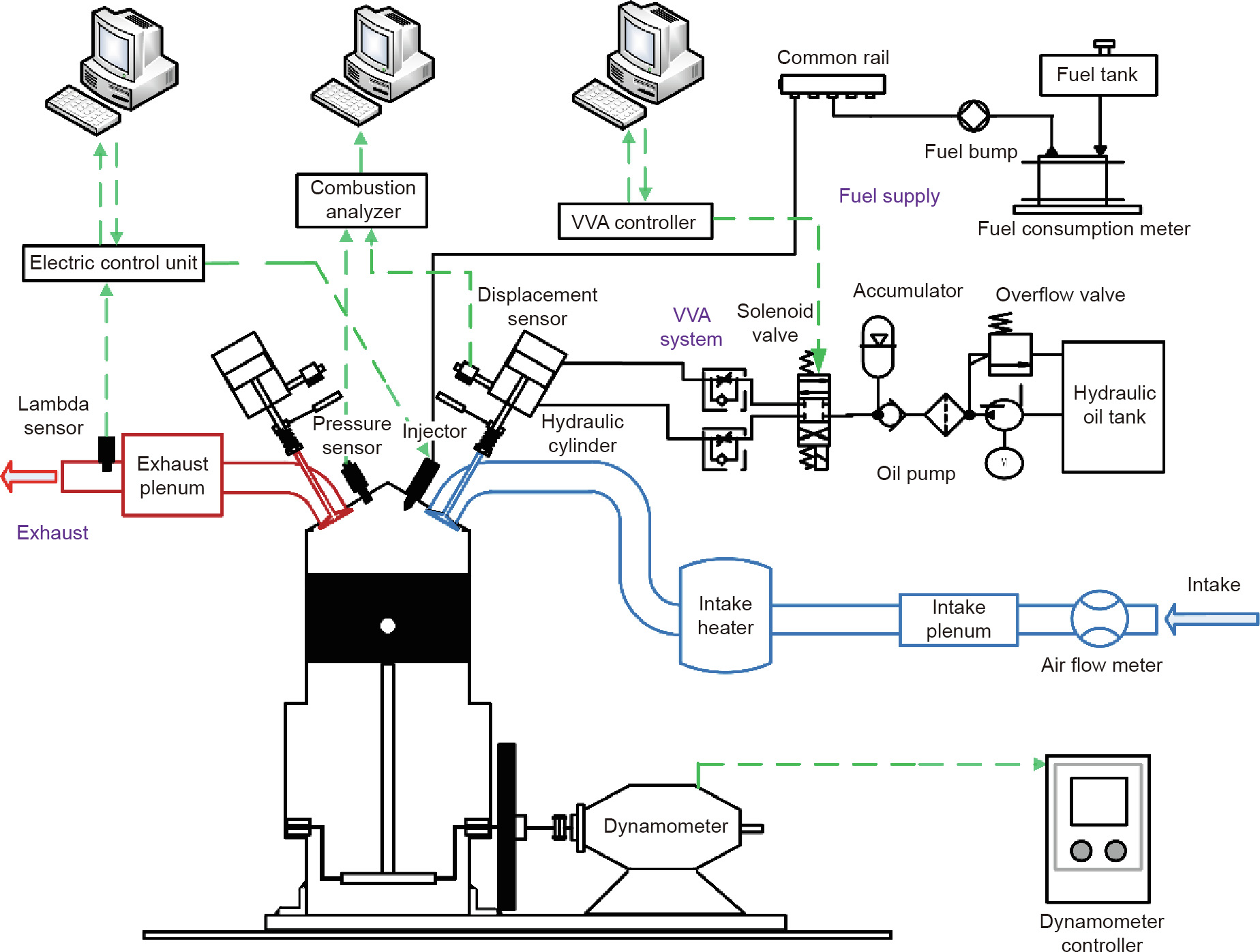
Fig. 1. Schematic of engine and experimental apparatus. VVA: variable valve actuation.
《Fig. 2》

Fig. 2. Spray photos of the piezoelectric injector with 20 MPa injection pressure and 0.1 MPa ambient pressure. t: the time after the start of injection (SOI).
《Table 1》
Table 1 Specifications of the experimental engine.

Fig. 1 shows the schematic of the engine and experimental apparatus. The engine speed was controlled by a DZC-20 direct current dynamometer with an uncertainty of ±0.2%. A Kistler 6118B pressure transducer installed in the cylinder head was used to collect the in-cylinder pressure signal. The pressure signal was amplified by a Kistler 5018 charge amplifier and recorded by a combustion analyzer. With the utilization of a photoelectric encoder, the pressure signal was gathered with a resolution of 0.1 crank angle degree (°CA). The valve lifts were measured using KEYENCE EX-422V displacement sensors. Fuel consumption was measured by a fuel-consumption meter with a range of 6 kg·h-1 and an uncertainty of ±0.2%. Coolant and oil temperatures were monitored and adjusted by a Siemens PID controller, and the temperature fluctuation of the coolant was controlled within 2°C. The mass flow rate of the intake air was measured by a Toceil LFE060 flow meter with an uncertainty of ±1%.
《2.2. Test operations》
2.2. Test operations
In this experiment, the symmetric NVO was kept at 140°CA and the engine speed was maintained at 800 r·min-1 to ensure stable combustion of GCI under low load conditions. Table 2 lists the detailed control parameters of the experiment. The intake pressure was kept at 0.1 MPa, while the coolant and intake temperatures differed under different testing operations. The engine was fueled with research octane number (RON) 92 Shell gasoline, the properties of which are shown in Table 3. The pressure signal of 200 continuous cycles was collected under every working condition.
《Table 2》
Table 2 Control parameters of the experiments.

RON: research octane number.
《Table 3》
Table 3 Properties of the gasoline fuel used in the experiments.
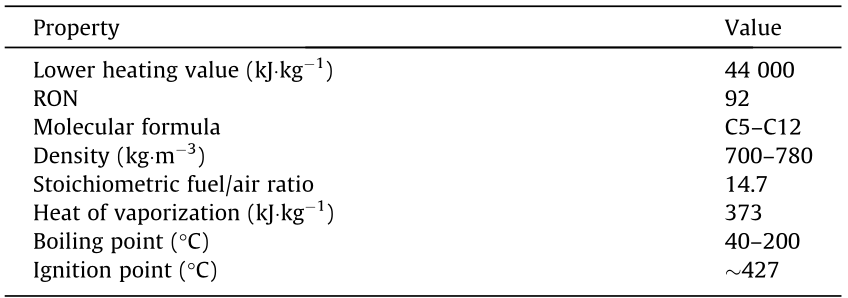
In the present work, three injection strategies were compared under both stable and cold-start operations. The injection strategies, which included the NVO injection, HCCI injection, and partially premixed combustion (PPC) injection strategies, are depicted in Fig. 3. The injection pressure for all three injection strategies was kept constant at 20 MPa. The injection timing of the NVO injection strategy was after exhaust valve close (EVC), which is 400 CA before top dead center (bTDC), and the injected fuel could be reformed due to the hot trapped gas and piston compression. For the HCCI strategy, the fuel was injected into the combustion chamber at intake valve open (IVO) timing, which is 290°CA bTDC, in order to obtain a homogeneous charge. The injection timing of the PPC strategy was during the compression stroke in order to achieve proper fuel stratification in the combustion chamber. For each fuel supply (6, 9, and 12 mg per cycle), the optimized injection timings for PPC were 32, 42, and 60 CA bTDC, respectively.
《Fig. 3》

Fig. 3. Valve lifts and injection strategies of the experiment. Inj.: injection.
In the actual operation of an engine, several steps are always needed to start a vehicle: ① firing with a cold engine; ② stable operation for a period of time to warm up the engine (engine warming-up); ③ the operations that are required to move the vehicle. Therefore, the experimental operations were divided into two groups: First, a combustion stability analysis of low load stable conditions was carried out to determine the engine warming-up conditions. Second, the firing strategy of a GCI engine was studied to realize a quick firing process.
In the experiment, the minimum fuel supply to maintain stable GCI combustion was found to be about 6 mg per cycle under steady and fully warmed-up conditions. Under warming-up and coldengine-firing conditions, however, more fuel is always needed to meet the required combustion stability. Therefore, the fuel supply in the testing operations was set to 1, 1.5, and 2 times the minimum fuel supply, which were 6, 9, and 12 mg per cycle. One of the goals of this work was to determine the most appropriate fuel supply for engine warming-up and cold engine firing. When conducting the stability experiments, the intake temperature was kept at 15 C and the coolant temperature was reduced from 65 to 25°C. (Details of the testing operations are listed in Table 4.) The conditions of normal atmospheric temperature of the intake air (15°C) and an unheated coolant (25°C) were essential, because after the firing process of a cold engine, the engine operates under these conditions. The aim of the stability analysis was to determine an optimal strategy with an appropriate fuel supply and injection for engine operations after the firing process with a cold engine. In experiments of GCI firing with a cold engine, different coolant temperatures and intake temperatures were tested, which are listed in Table 5. When conducting the cold-engine-firing experiments, the engine was first motored to 800 r·min-1 . Meanwhile, as the fuel was injected into the combustion chamber, recording of the in-cylinder pressure was triggered. To ensure the repeatability of the experiments, the cold start was repeated three times for each boundary condition. After each test, the engine was motored without fuel for several minutes until the exhaust temperature decreased to a stable value. In addition, the coolant circulation was switched off during the cold-start cycles to reduce heat dissipation, which is the same control strategy used in a real engine. It must be noted that in an actual engine, there is an acceleration process of the engine speed from ~200 to ~800 r·min-1 during the cold-start process. However, it was not definite that the testing strategies in the present work would achieve firing in the coldstart process. Furthermore, even if firing is achieved, acceleration of the engine speed brings additional uncertainties to the experiments. The goal of this work was to determine appropriate methods to achieve a stable firing process as quickly as possible. Thus, we finally chose a constant engine speed—more specifically, a typical idling speed—with which to conduct the experiments. Better firing capacity in these experiments reflects better cold-start capacity in real engines.
《Table 4》
Table 4 Testing operations for low load stable combustion.

The intake temperature was set to 15°C and the fuel supply was set to 6, 9, and 12 mg per cycle.
The injection timings of the PPC strategy with a fuel supply of 6, 9, and 12 mg per cycle are 32, 42, and 60°CA bTDC, respectively.
《Table 5》
Table 5 Testing operations for GCI cold-start experiment.
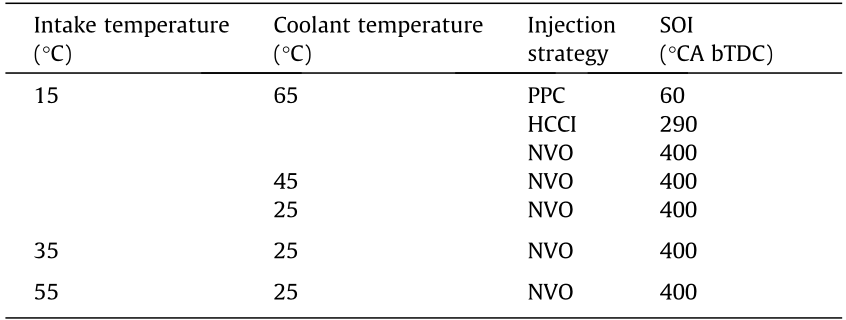
The fuel supply was set to 12 mg per cycle.
《3. Results and discussion》
3. Results and discussion
《3.1. Combustion stability investigations under low load conditions》
3.1. Combustion stability investigations under low load conditions
As mentioned above, the experiments were divided into two parts: a combustion stability investigation and a cold-start experiment. In the stability experiment, the goal was to determine the optimal strategy of injection timing and fuel supply to maintain stable combustion, even though the intake air and coolant were unheated.
3.1.1. Effects of fuel-injection strategy on combustion stability
Different injection strategies with different fuel supplies are shown in Fig. 4. The crank angle at 50% mass burned (CA50) is used to be the indicator of combustion phase. And this figure clearly shows that the NVO injection strategy has the most advanced CA50, but its IMEP is the lowest among those of the three injection strategies. The coefficient of cyclic variation (CoV) of the NVO injection strategy is also the lowest, with a fuel supply greater than 9 mg per cycle. In other words, the unburned mixture of this injection strategy has the highest reactivity due to the fuel-reforming process, making this strategy the most suitable for engine warmup. The HCCI strategy has the highest IMEP as long as the combustion is stable, which means that the thermal efficiency of HCCI is the highest in comparison with the other two strategies. Therefore, the HCCI strategy is the most suitable for power output under light-duty working conditions. The PPC strategy remains stable even with a very low fuel supply (6 mg per cycle); thus, it can be used in idle conditions after engine warm-up.
《Fig. 4》

Fig. 4. IMEP, CA50, and CoV with different fuel supplies under the condition of a coolant temperature of 65°C and an intake temperature of 15°C. CA50: crank angle at 50% mass burned; CoV: coefficient of cyclic variation.
To enable further study of the combustion characteristics of the three injection strategies, Fig. 5 compares the in-cylinder pressure and heat-release rate (HRR) with a fuel supply of 9 and 12 mg per cycle. The profiles of the NVO injection strategy and the HCCI strategy are quite similar, with the only difference being the combustion phase. Higher reactivity of the mixture with the NVO injection strategy leads to a shorter ignition delay time and an early start for the combustion timing. With fuel supplies of both 9 and 12 mg per cycle, the PPC strategy always maintains the highest HRR peak among the three strategies, which is due to appropriate fuel stratification in the combustion chamber. This fuel stratification is needed for stable auto-ignition when the fuel supply is very small, which explains why the PPC strategy is most suitable for engine idling. In addition, it is noticeable that the incylinder pressure of the different injection strategies differs after the fuel has burned out, with that of the NVO injection being especially low compared with the other two strategies. And this phenomenon brings bad effect to the work and power output of an engine.
《Fig. 5》

Fig. 5. In-cylinder pressure and HRR of the three injection strategies with different fuel supplies.
The pressure–volume (P–V) diagrams of the HCCI and NVO injections with a logarithmic coordinate axis and a fuel supply of 12 mg per cycle are plotted in Fig. 6. It is apparent that the positive work of the HCCI injection is greater than that of the NVO injection, and the negative work of the HCCI injection strategy is also greater than that of the NVO injection strategy. The differences between the two injection strategies, including the combustion phase, work output, and so forth, are caused by the fuel-reforming process. During the NVO period, hot exhaust gas is trapped in the combustion chamber. When fuel is injected into the cylinder, a chemical reaction occurs between the fuel and the hot gas to form smallmolecule products with very high chemical reactivity. According to gas-sampling investigations by Wolk et al. [24], the reforming products of iso-octane include H2, CO, CH4, C2H2, C3H3, C2H4, and CH2O. Acetylene (C2H2) has been identified as having the largest impact on increasing reformate reactivity due to its strong relative impact on reactivity and high concentration. The existence of these highly reactive products decreases the auto-ignition delay, advancing the start of combustion and the combustion phase. However, the fuel-reforming process results in an increase of heat-transfer loss and excessive advanced combustion phasing, which are the reasons for the lower work output. Thus, the NVO injection strategy is not appropriate for power output due to fuel loss from the reforming process, but it is suitable for engine warm-up due to the high reactivity of the reforming products.
《Fig. 6》

Fig. 6. P–V diagram of the HCCI and NVO injection strategies with a fuel supply of 12 mg per cycle.
3.1.2. Effects of coolant temperature on combustion stability
Given the considerations discussed above, a fuel supply of 12 mg per cycle was chosen in order to ensure stable combustion, even though the associated IMEP values would be high for normal idle operation. To achieve engine warm-up conditions, the intake temperature and coolant temperature must be reduced to room temperature. Therefore, the coolant temperature was reduced from 65 to 25°C.
Fig. 7 shows the CA50 and CoV for different coolant temperatures. Unsurprisingly, combustion with the NVO injection strategy is stable when the coolant temperature is decreased to room temperature. The combustion stabilities of the HCCI and PPC strategies are similar; both become unstable when the coolant temperature is below 45°C. In addition, the combustion phase CA50 of the NVO strategy is less sensitive than those of the other two strategies, due to the highly reactive products created by fuel reforming. Unexpectedly, however, the combustion phase CA50 of the HCCI strategy remains almost unchanged when the coolant temperature is decreased from 45 to 25°C. Thus, further analysis is necessary for the coolant temperatures of 45 and 25°C.
《Fig. 7》

Fig. 7. CA50 and CoV for different coolant temperatures with a 15°C intake temperature.
The in-cylinder pressure and HRR are shown in Fig. 8. When the coolant temperature is decreased from 45 to 25°C, the peak of the HRR decreases slightly with the NVO injection. However, the HRR of the HCCI and PPC strategies becomes extremely low when the coolant temperature is decreased to 25°C. In addition, the start of combustion with these two strategies moves forward somewhat, because the combustion cycles for the HRR calculation are unstable. That is, the very strange HRRs that occur with a coolant temperature of 25°C are mainly caused by the coexistence of knocking cycles with a very advanced combustion phase, misfire combustion cycles, and very retarded combustion cycles, which are shown in Fig. 9 and Fig. 10.
《Fig. 8》

Fig. 8. Pressure and HRR for different coolant temperatures and injection strategies. Tc: coolant temperature.
《Fig. 9》

Fig. 9. Distributions of maximum pressure and the corresponding crank angle for different strategies and coolant temperatures.
《Fig. 10》
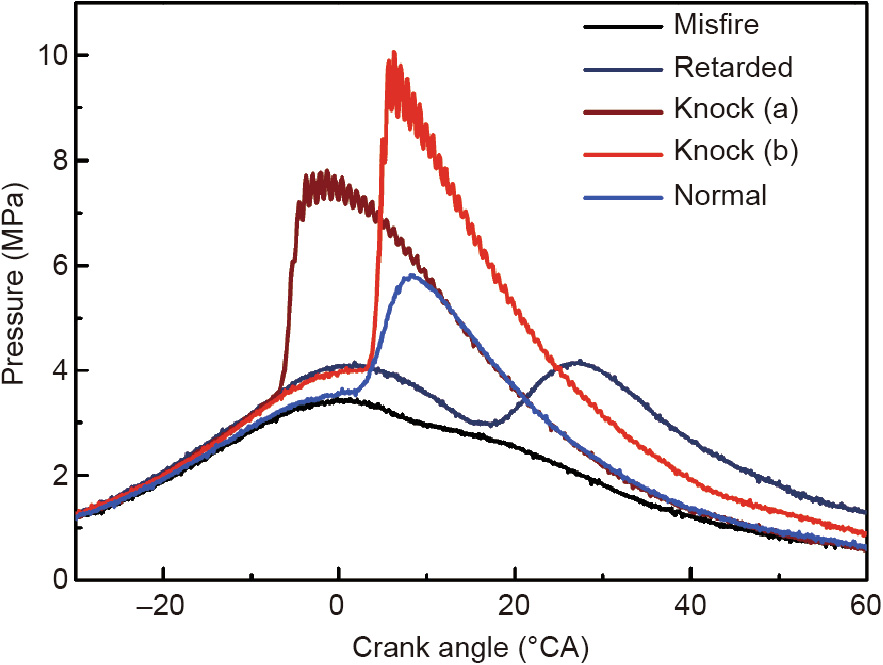
Fig. 10. Coexistence of typical unstable PPC combustion cycles with a coolant temperature of 25°C.
Fig. 9 shows the distributions of the maximum in-cylinder pressure and its corresponding crank angle degree for different injection strategies and coolant temperatures. It is clear that the pressure distributions for the NVO injection strategy are very concentrated, whereas the distributions of the other two injection strategies are considerably scattered when a 25°C coolant temperature is used. Under this condition, it is difficult to produce stable auto-ignition in the combustion chamber with such low thermodynamic state using the HCCI and PPC injection strategies, which results in the coexistence of knocking cycles, misfiring cycles, and retarded cycles. Fig. 10 displays the pressure of the typical combustion cycles with the PPC strategy. Under this working condition, which involves a great deal of burned residual gas, the combustion process of the previous cycle has a strong influence on the initial state—including the mixture temperature, gas component, O2/CO2 concentration, and so forth—of the next combustion cycle. Consequently, the rather high CoV causes great differences in the initial state of different combustion cycles. This is the main reason for the coexistence of knocking, misfiring, normal and retarded combustion cycles. It should be noted that a similar phenomenon occurs for the HCCI strategy with a cold coolant temperature (25°C).
《3.2. Investigation of the cold-firing capacity of a GCI engine》
3.2. Investigation of the cold-firing capacity of a GCI engine
3.2.1. Strategic investigation of the GCI cold-firing process
This section describes the use of the IMEP and CA50 trajectories to monitor the GCI cold-start process; an engine cold start is regarded as successful when no obvious fluctuation of CA50 and IMEP are observed. As discussed above, with a fuel supply of 12 mg per cycle and a coolant temperature of 65°C, all three strategies are able to sustain stable combustion at a steady state, although the corresponding high IMEP would result in accelerating the engine speed in a cranking process. Therefore, the cold-start experiment was conducted under these conditions, with the results shown in Fig. 11. It can be seen that the firing processes are stabilized as the cycle number increases; this is because heat is accumulated in the combustion chamber by the incomplete combustion of the first cycles and the large amount of trapped residual gas. Once the heat has accumulated to some degree, the initial in-cylinder temperature is sufficient to generate stable ignition in the combustion chamber. The NVO injection strategy starts the most quickly and the IMEP values stabilize within about 20 cycles, which takes about 3 s at a speed of 800 r·min-1 in the experiment. The HCCI and PPC strategies require over 40 combustion cycles to stabilize the IMEPs, making them unsuitable for cold-start conditions.
《Fig. 11》

Fig. 11. IMEP and CA50 changing trajectories for three different injection strategies in an engine-firing experiment with a coolant temperature of 65°C and a fuel supply of 12 mg per cycle. (CA50 points for cases where IMEP = 0 were removed.)
Under GCI cold-start conditions, the initial thermodynamic state, reactivity of the unburned mixture, and heat-accumulation rate are decisive factors in an engine’s starting capacity. For the NVO injection strategy, the fuel injected into the combustion chamber is compressed twice every cycle. The low-temperature chemical reaction that occurs during NVO period promotes the heat accumulation process and produces products with high reactivity. Therefore, the NVO injection strategy was selected for use in the other cold start experiments in this work.
To further study the cold-start capacity of GCI, tests must be conducted using the actual boundary conditions of a cold engine. In this part of the experiment, the intake temperature remained unchanged at 15°C, while the coolant temperature was reduced from 65 to 25°C. The trajectories of the IMEP and CA50 are shown in Fig. 12. The results demonstrate that reducing the coolant temperature decreases the cold-start capacity of a GCI engine. Fig. 12 also shows cold-start failure with the coolant at 25°C. This is because with unheated intake air and coolant, no chemical reaction occurs in the combustion chamber. In the GCI cold-start process, the first chemical reaction cycle is important, as it initiates the heat accumulation that continues cycle by cycle. Since a large amount of residual gas exists in the cylinder, heat accumulation by low-temperature chemical reactions increases the temperature in combustion chamber. Finally, auto-ignition occurs when the temperature is high enough, resulting in the GCI engine starting successfully. In contrast, as shown in Fig. 12, with an unheated coolant temperature, the absence of the chemical reaction cycle results in a lack of heat accumulation in the cylinder, and finally results in failure of the GCI cold start.
《Fig. 12》
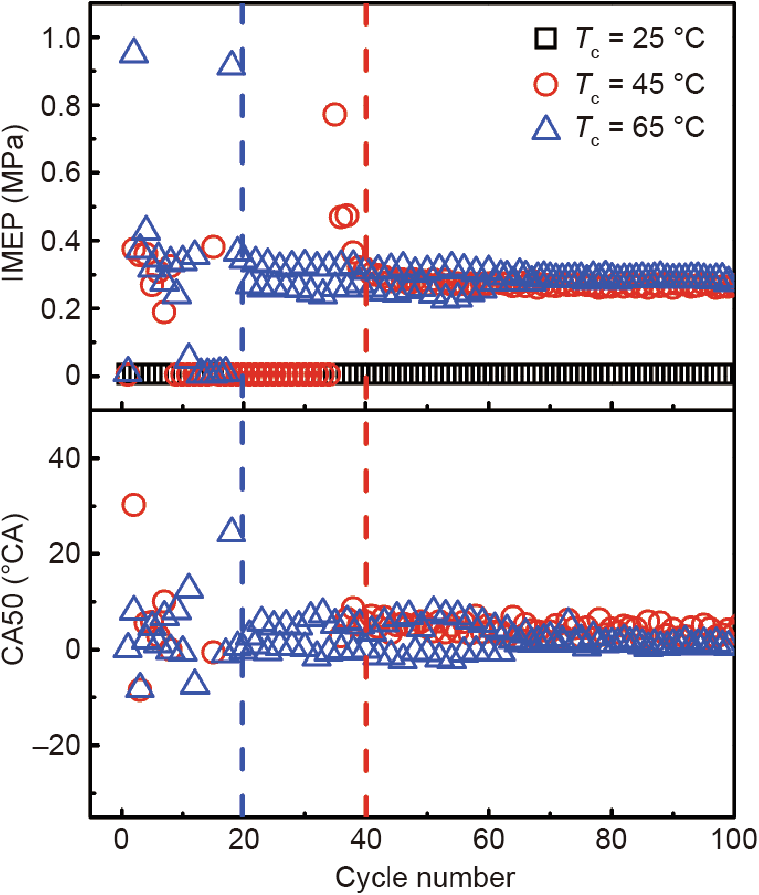
Fig. 12. IMEP and CA50 changing trajectories with different coolant temperatures in a GCI engine-firing experiment with the NVO injection strategy and a fuel supply of 12 mg per cycle. (CA50 points for cases where IMEP = 0 have been removed.)
In actual situations with an engine cold start, the coolant is always at normal atmospheric temperature. In order to solve the cold-start problem before the engine warms up, intake preheating was conducted. In these experiments, the engine was motored at a speed of 800 r·min-1 ; next, the intake air was heated to 35°C or 55°C. Once the intake air and engine speed were stable, the fuel was injected into the cylinder and data recording was triggered. Fig. 13 shows the resulting IMEP and CA50 trajectories. With an intake temperature of 35°C, the cold start still fails; however, with a higher intake temperature of 55°C, the mixture in the combustion chamber ignites immediately, and the engine starts successfully with only four combustion cycles (about 0.6 s in the experiment). After four combustion cycles, the IMEP and CA50 remain quite stable.
《Fig. 13》

Fig. 13. IMEP and CA50 changing trajectories with intake preheating in a GCI engine-firing experiment with the NVO injection strategy, 25°C coolant temperature, and 12 mg per cycle fuel supply. TI: intake temperature. (CA50 points for cases where IMEP = 0 have been removed.)
It is noticeable in Fig. 13 that for an intake temperature of 55°C, the IMEP of the first combustion cycle is extremely high, but it then decreases in the following several combustion cycles. To understand the combustion process of these subsequent cycles, the in-cylinder pressure signal and the filtered pressure were plotted, as shown in Fig. 14. Under these cold-start conditions, the first combustion cycle has a relatively late combustion phase but a very high in-cylinder pressure. This is because no residual gas exists before combustion, and the high oxygen (O2) concentration results in rapid combustion. After this cycle, cycle 2 clearly has a more advanced combustion phase, due to the heating effect of the hot residual gas. In addition, slight pressure oscillations (0.03 MPa) can be observed in this cycle. After that, the amount of hot residual gas continues to increase and tends to be stable, and the pressure oscillation gradually disappears. In cycle 5, the pressure (shown as a green line) coincides with the pressures of the stable conditions (gray lines), and the combustion becomes stable after the GCI cold start.
《Fig. 14》

Fig. 14. Pressure and filtered pressure of the first several combustion cycles during the GCI engine-firing process with the NVO injection strategy, 55°C intake temperature, 25°C coolant temperature, and 12 mg per cycle fuel supply.
Since application of the NVO injection strategy permits stable combustion with the intake air and coolant kept at room temperature, this strategy can be combined with the intake preheating strategy in order to achieve a fast cold start and subsequent warm-up conditions in a GCI engine.
3.2.2. Comparison between intake preheating and coolant preheating for the GCI cold-firing process
In the actual operation of an engine, there are two common types of cold-start conditions. The first is a cold start before the engine warms up (with cold intake air and cold coolant); the second is engine starting with a hot coolant. In the first case, intake preheating is required, whereas in the second case, intake preheating is unnecessary. Fig. 15 compares the starting capacity of the two types of common cold-start conditions. For a cold start with a cold coolant, the temperature of the intake air must be high enough to trigger the chemical reactions. However, with a fuel supply of 9 mg per cycle (group 1 in Fig. 15), the cold start fails, which means that the fuel is too lean to be reacted. With the boundary conditions unchanged but an increasing fuel supply (group 2), the engine successfully starts in less than five cycles, which demonstrates the importance of fuel concentration to the chemical reactions in the combustion chamber.
《Fig. 15》
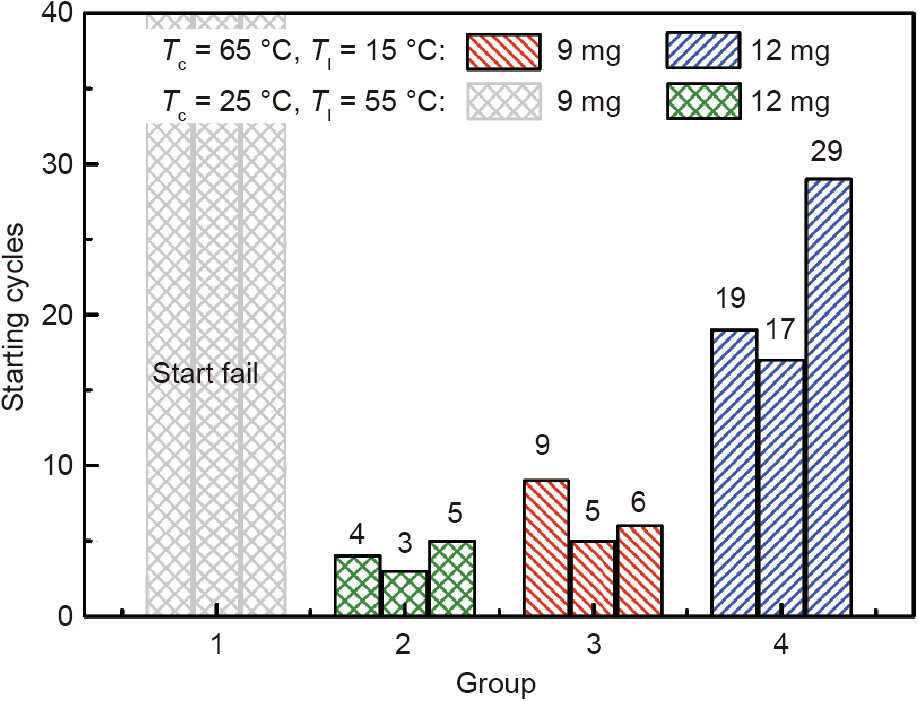
Fig. 15. A comparison between two types of common engine-firing conditions using the NVO injection strategy.
However, when the engine starts with a hot coolant, the conditions with a 9 mg per cycle fuel supply (group 3) result in a better starting capacity than the conditions with a 12 mg per cycle fuel supply (group 4), which is exactly the opposite influence in comparison with group 1 and 2. This is because—for fuel supplies of both 9 and 12 mg per cycle—the local hot region near the cylinder wall is enough to initiate the fuel-reforming process and the lowtemperature chemical reactions in order to obtain heat accumulation. For group 1, however, the fuel is too lean to react, and no local hot region is available to improve the reactivity. An interesting phenomenon, as shown in Fig. 16, is that misfire happens after several combustion cycles with a fuel supply of 12 mg per cycle. This might be caused by the wetting effect of the piston top due to the injection timing of 400°CA bTDC.
《Fig. 16》
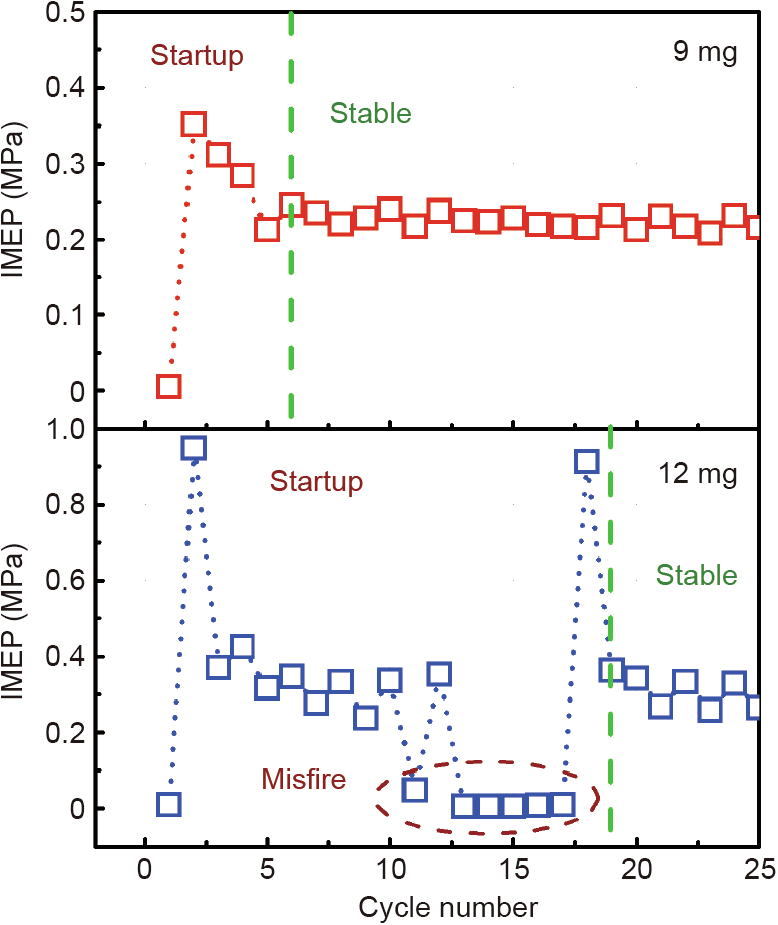
Fig. 16. IMEP trajectories of the firing process with 65°C coolant temperature, the NVO injection strategy, and different fuel supplies.
In other words, if the coolant is cold, intake preheating is necessary for a GCI cold start, and the fuel supply must be sufficient to avoid start failure; if the coolant is hot, however, intake preheating is not essential, and the fuel supply must be carefully controlled to avoid misfire combustion after several combustion cycles.
《4. Conclusions》
4. Conclusions
In this work, the low load combustion stabilities of different injection strategies were determined for a GCI engine. Cold-start strategies were also investigated. The main conclusions are as follows:
(1) Among the three strategies of HCCI, PPC, and NVO injection, combustion with the NVO injection strategy has the most advanced combustion phase; the PPC strategy can maintain stable combustion with the lowest fuel supply, which is suitable for idling; and the HCCI strategy has the highest IMEP, which indicates the best fuel economy.
(2) With the HCCI and PPC strategies, decreasing the coolant temperature from 65 to 25 °C results in unstable combustion and the coexistence of knocking, misfiring, and normal cycles. However, combustion with NVO injection is less sensitive to the changing of the coolant temperature due to the highly reactive products created by fuel reforming. Thus, a stable combustion process can be maintained with the intake air and coolant at room temperature. Therefore, the NVO injection strategy can be used to warm up a GCI engine.
(3) The initial thermodynamic state, reactivity of the unburned mixture, and heat-accumulation rate are decisive factors in the firing process of a GCI engine. The NVO injection strategy was shown to be the most suitable injection strategy for firing a GCI engine due to fast heat accumulation and the existence of highly reactive products as a result of in-cylinder fuel reforming. With cold intake air and coolant, however, failure of engine firing was observed due to the absence of chemical reactions and heat accumulation. Under such conditions, intake preheating is an effective way to improve the firing capacity, as it enables the engine to start successfully within five cycles.
(4) When the coolant is cold, intake preheating is necessary, and the fuel supply must be sufficient to avoid failure of firing; but when the coolant is hot, intake preheating is not essential, and the fuel supply must be carefully controlled to optimize the duration of the unstable firing process.
It is noted that the present work only focuses on achieving an in-cylinder combustion cold start by means of different technologies, and does not consider hydrocarbon and carbon monoxide control. Therefore, further research on emissions control will be performed in future.
《Acknowledgements》
Acknowledgements
The work was supported by the National Natural Science Foundation of China (91641203, 51476114, and 91741119) and the National Key Research and Development Program of China (2017YFB0103400).
《Compliance with ethics guidelines》
Compliance with ethics guidelines
Lei Zhou, Jianxiong Hua, Haiqiao Wei, and Yiyong Han declare that they have no conflict of interest or financial conflicts to disclose.
《Nomenclature》
Nomenclature
bTDC before top dead center
°CA crank angle degree
CoV coefficient of cyclic variation
CA50 crank angle at 50% mass burned
EGR exhaust gas recirculation
EVC exhaust valve close
GCI gasoline compression ignition
HCCI homogeneous charge compression ignition
HRR heat-release rate
IVO intake valve open IMEP indicated mean effective pressure
NVO negative valve overlap PPC partially premixed combustion
PCCI premixed charge compression ignition
PM particulate matter
RON research octane number
SI spark ignition
SOI start of injection
VVA variable valve actuation














 京公网安备 11010502051620号
京公网安备 11010502051620号




